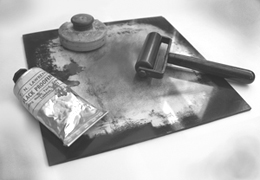| FOREWORD
by Simon Brett, former Chairman of the Society of Wood Engravers and compiler of 'An Engraver's Globe'. |
|
The immediacy of James Bostock's
wood engravings makes time collapse, yet they are also rooted in the
decades in which they were produced. In this most welcome catalogue
we can reconcile the vivid impact of his art, the rather different
sense of time we carry within us, and the actual chronology which
Hilary Chapman has so valuably researched. Though only one print dates from the nineteen-thirties, Bostock's work first seems to speak to us with the accent of that decade, which is only natural. In common with many others, his career suffered the major interruption of the Second World War, which took six years of his life just where his education finished and his mature development should have begun. He picked up after it, therefore, with styles and attitudes formed before it.  By the nineteen-fifties, however, his essays in Hayteresque modernism were completely up-to-the-minute; and the social scene depicted in Train Coming and Greengrocers is also perfectly true to the decade - my childhood - though it feels so much longer ago now. Our memories play us tricks. These prints remind us how much art was still in 'post-war mode' not only throughout the 'fifties but well into the 'sixties. They speak from before the watershed of that later period. After it, neither art nor the place of wood engraving within it, was quite the same, but the change did not really happen until late in the decade. James Bostock was fifty then, and well established in his manner of working; but, just at that point, he became so busy with teaching that it caused a second interruption in the production of his prints. So the correspondence between Ducks in the Wood of 1946 and Black Park I of 1960 should not surprise us. Those virtuoso engravings Brentford Lock and The Mirror, with their Hayteresque swirls, demonstrate, as they must have done to the artist at the time, that there was every bit as much rhythm in his more naturalistic landscapes. When he picked up his burin afresh in the early nineteen-eighties, after retiring from teaching and administration, it is right that it was in a different mode and spirit again. What wetter waves have ever broken onto paper! Considerable tonal risks are taken in Positano and Near Ullswater, made of shifting greys rather than the bold blacks and whites of earlier years. These prints impose less on nature. They have a touching awe before it. Yet across fifty years there is an immediately recognisable consistency; the work of a long life united by a vivid and ebullient enthusiasm for the things seen. |